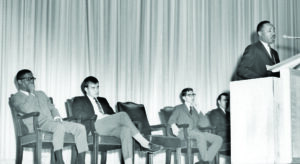By Nancy George
It’s hidden history for most people that Dr. Martin Luther King, Jr. spoke at SMU March 17, 1966, at the invitation of the Student Senate. His remarks transfixed the standing-room only audience of SMU students, faculty and staff and changed the lives of students who had the opportunity to meet him.

Photo courtesy of SMU
Fifty-seven years later, SMU students again took the lead to put Dr. King’s visit to SMU into the spotlight and bring its impact to future generations. With assistance from SMU faculty and staff, the students put into motion the application that has earned a Texas Historical Commission marker for McFarlin Auditorium, where Dr. King spoke.
King’s speech will be honored, and the historical marker will be dedicated at a community-wide event at 6:30 p.m. Tuesday, Feb. 21, at McFarlin Auditorium on the SMU campus. Admission is complimentary and registration is required.
The evening will feature SMU President R. Gerald Turner, Dallas Mayor Eric Johnson, the Rev. Richie Butler ’93, SMU students who pursued the historic designation and the St. Luke Community UMC Choir. Butler, SMU alumnus and trustee, pastor of St. Luke Community UMC and founder of Project Unity, will speak on the legacy and long-term impact of King’s visit to campus.
The renowned civil rights leader spoke for 60 minutes without notes on that afternoon in 1966. He spoke of the first enslaved people who arrived on American shores in 1619, the struggles and heartbreak faced by their descendants, court battles and victories and the long road ahead for racial justice. His speech balanced hope with reality and called for continuing passionate and unrelenting work for racial justice.
As a Student Senate officer at the time, now retired Methodist minister Charles Cox ’67, ’75, ’79 and fellow student Bert Moore ’66 met Dr. King at the airport and hosted him during his Dallas visit. “His talk was received very enthusiastically by the crowd of about 2,800,” he wrote his mother after the speech. “It was so exciting to be with him that long of a time, to lead him everywhere and get to talk with him personally . . . I’ll never forget the experience.”
Moore kept the acceptance letter that Dr. King wrote in a lockbox at his home until his death in 2015. An accomplished psychologist, university administrator and researcher, Moore’s obituary included his meeting with Dr. King as one of the most important events of his life.
Jerry LeVias ’69, the storied SMU football player who was the first Black athlete to receive an athletic scholarship in the Southwest Conference, met Dr. King that day at a meeting arranged by SMU President Willis Tate. LeVias was nearing the end of his first year on campus as a freshman football recruit, enduring harsh and constant racism even from his teammates.
“Dr. King told me to always keep my emotions in control,” said LeVias, recounting the conversation in the oral history he recorded for SMU’s Voices of SMU.
Fred Hegi ’66, then treasurer of the Student Senate and now an SMU trustee, sat on the stage with Dr. King and the other student officers.
“We knew bringing Dr. King to campus was a somewhat risky proposition,” Hegi said, alluding to the controversy that dogged the civil rights leader. The last Gallup Poll taken in King’s lifetime occurred that same year, and revealed him to have an unfavorable rating of 63 percent. “But Willis Tate was a masterful leader. His respectfulness and determination for a successful and safe visit set the tone.”
This might have been forgotten by the 1980s, were it not for Clarence Glover, Jr., then director of Intercultural Education and Minority Student Affairs at SMU. University President Willis Tate encouraged him to research records of Dr. King’s visit in the DeGolyer Library archives where he found the recording of Dr. King’s remarks. Glover’s discovery of the recording, combined with information from The Daily Campus student newspaper clippings, led to SMU’s annual Unity Walk — a tradition honoring Dr. King for more than 30 years now — and paved the way for the next group of students to continue the work.
In addition to creating a carefully documented research paper, obtaining a historic marker requires multiple steps before submitting the application during a specific 10-week window.
“What really pushed this forward the summer of 2020 was the Black Lives Matter movement,” said student Lamisa Mustafa. “There was so much energy and momentum for racial justice on our campus, it seemed like now or never.
“The marker will be constant reminder that Dr. King’s work is never-ending, there isn’t a finish line,” she said. “It’s a reminder of what is possible.”
